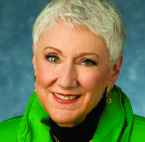Hadassah
President's Column
President’s Column: Building Code
 The Sarah Wetsman Davidson Hospital Tower, Hadassah’s state-of-the-art inpatient center in Jerusalem, is a reality. The first patients moved in on March 19 and every few weeks another department moves in. By the middle of 2013, the tower’s 19 floors—14 aboveground and 5 below—will be fully occupied.
The Sarah Wetsman Davidson Hospital Tower, Hadassah’s state-of-the-art inpatient center in Jerusalem, is a reality. The first patients moved in on March 19 and every few weeks another department moves in. By the middle of 2013, the tower’s 19 floors—14 aboveground and 5 below—will be fully occupied.The tower now anchors a hospital complex that also includes the Charlotte R. Bloomberg Mother and Child Center, the Judy and Sidney Swartz Center for Emergency Medicine and the Hadassah Cancer Center. We expect to retrofit the former main building of the Ein Kerem campus to serve as an outpatient and research center.
We used a popular saying during the construction of the Davidson Tower: “At Hadassah, we’re not waiting for the future, we’re building it.” It’s a catchy slogan that describes not only this project, but also says a lot about our history of building institutions in Israel over the past 100 years.
But even as the saying trips so easily off the tongue, I think it bears a closer look—for how it represents the harmony of purpose between Hadassah and Israel and also for what the words do not say.
For 2,000 years, the people of Israel lived in exile. The nation of Israel was more a thing of the past than the future, a dream more than a place. Jews prayed for the restoration of their sovereignty and some even returned to live in the Land of Israel. But there was little concrete action designed to bring about Jewish national independence.
That changed with the birth of the Zionist movement. The pioneers of the late 19th and early 20th centuries built cities and towns, restored agriculture, established institutions and businesses, developed a culture and even revived the Hebrew language. Hadassah became the dominant builder of prestate Israel’s health care infrastructure and important parts of its educational foundation.
After gaining independence in 1948, key issues remained unsettled. Israel was forced to fight (and still fights) repeated wars to defend its existence and has also struggled to defend its right of self-defense in the international community. Most nations that recognize Israel as a state still do not officially recognize Jerusalem as the nation’s capital city.
The War of Independence also left Hadassah cut off from our hospital on Mount Scopus, leading us to build the Ein Kerem campus—where the Davidson Tower is now a prominent feature of the Jerusalem landscape.
One of the things that most appeals to me about our building slogan is that it does not say we are building for the future. Building for the future is an aspiration but building the future itself is an action. There was no future health care system in Israel until we laid the foundation. There was no future metropolis of Jerusalem until we and the rest of the Yishuv took it upon ourselves to create one.
The landscape of Israel has been transformed over the past century because the Zionist revolution was as much psychological as political. It taught us that we couldn’t wait any longer. Rather than have confidence in the future, we would have confidence in ourselves. If we did, the future would sort itself out.
We just celebrated Yom Yerushalayim, the anniversary of the day Jerusalem was reunified in 1967—in the same war that also returned Hadassah Mount Scopus to us. The final boundaries of Israel, and even of Jerusalem, may still be in doubt, but there is no doubt about our course of action. We have to continue building the future.
Whatever the ultimate configuration of peace, the lines on the map, the routes of the buses or the location of embassies, we must keep working. If we build, the future will follow.
I hope every member of Hadassah will take advantage of the opportunity to see the future as we have created it. The official dedication of the Davidson Tower will take place in October, during our Centennial Convention in Jerusalem. A good slogan can motivate and inspire, but there’s really no substitute to seeing with your own eyes, touching with your own hands, the tower that all of us built.










 Facebook
Facebook Instagram
Instagram Twitter
Twitter
Leave a Reply